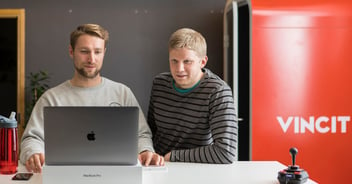In the distant past, when people still huddled together to meet each other in large numbers, people from the Finnish Association of Facilitators (FAFA) visited Vincit to learn about retrospectives and their facilitation. I started writing a blog entry after the event (17 February 2020), but it was soon buried beneath other things. Now, for quite obvious reasons, publishing the text without a virtual facilitation perspective would seem ancient, which is why, in keeping with the times, the text below will also touch upon how retros can be held remotely in this day and age.
What is a retrospective?
Vincit has previously published a retro-related blog entry, which gives a good idea about our understanding of the topic. In the following, I will give a quick recap and make a few observations about retros before moving on to the actual point of this text.
Retros originate from Scrum, which is a software product development framework. The point of a retro is to allow the development team to reflect on its work at the end of each development phase or sprint (e.g. every 2 weeks). This review gives rise to concrete, practice-related development measures that will be added to the backlog of the next sprint.
Team:
- thinks about what has gone well and what works
- considers things that could be improved or changed; and
- uses this information to select the things to develop.
The team will also hopefully draw up a plan about:
- how the development will be carried out
- when
- by whom; and
- how the implementation and benefits of the developed product will be monitored.
Regardless of whether the team follows Scrum to the tee or not, retrospectives represent an important tool for the team’s continuous improvement. More advanced teams use retros analytically in order to develop their activities through agile experiments, but getting to express what’s on your mind out loud is just as important. In addition to the traditional sprint retro, retrospectives can be held on different themes, such as staff mood, root cause analysis, quarterly returns analysis, etc. And considering the current world and work situation, retros provide a great tool for reflecting on, working on and overcomig various situations and their effects.
Whatever the theme of the retrospective is, it’s objective should always be thought about in advance, since it has an effect on who should be invited to participate in the retro and how the retro should be carried out. This takes us to the matter of facilitation.
Facilitation helps with carrying out retrospectives
Even though anyone can organize and carry out a retrospective without any training, knowing the basics of facilitation methods may help a lot. At its core, a retrospective is a workshop, which means that achieving the best results requires the participants’ active engagement. Active participation can be encouraged through psychological safety, which can be promoted by going through the rules at the beginning of the event and by taking into account people’s different communicational and behavioral patterns. For example, giving the participants some time to think about the topic at hand on their own before discussing it in the group will give the more introverted individuals a better chance of expressing their thoughts in case the group includes some dominating communicators. It’s also a good idea to always have the results of the group on display, so that the discussion stays on topic. In other words, time to bring out the sticky notes, flip charts and whiteboards.
If all the participants can’t physically attend the event, the Internetcan provide tools that make it possible to distribute the outcomes in digital form. Lately we’ve relied heavily on tool such as Google Jamboard, FunRetro and Digitaalinen Topaasia. Jonas Rajanto at Grape People has also graciously listed a number of other tools that can be used, and the Facebook Virtual Facilitation Finland group is currently very active as well.
I’ve noticed that retrospectives often have a couple of recurring problems. The first is simply having too few retrospectives to begin with. If retros aren’t organized frequently enough, the issues the retros are going to tackle will be too general to produce any concrete development measures. Another hurdle can arise if, for some reason or another, the team doesn’t get to talk about any technical matters due to the fact that the client takes part in the retro. Yet another problem concerns the lack of discussion on the content of development measures and implementation planning. This means there’s no ownership, and since any ideas that are expressed remain superficial and stuck in perpetual limbo. In such a scenario, continuous improvement never advances beyond water cooler talk.
These are the reasons why I recommend having regular and frequent retrospectives (e.g. every 2 or 4 weeks) and focusing on the quality, not quantity, of development measures. It’s a good idea to involve the client in the retros, at least as a product owner, but in a way that makes the team comfortable to discuss technical details as well. One good solution is to have the client only attend every other meeting, so that the team also has a chance to discuss matters among just themselves.
Plan your retrospectives in such a way that less time is spent on generating development ideas (quantity) and more time is spent on their elaboration (quality) and planning. The exercise methods used should be chosen to support this goal. The team should qualify the ideas it finds important and then develop them further. The ideas can be made more concrete with methods such as Idealogue, which can also help promote a feeling of ownership over the ideas.
A one-hour retro for 30 people?
But how do you plan a retrospective for 30 people and how can you do it in a way that produces results in just one hour? Below, I’ll first look at this question from a general perspective and then discuss an example taken from FAFA’s retro exercise.
First, the participants need to be divided into small groups of 5–6 people, which will carry out the exercises as parallel processes. This helps to ensure there’s enough time even though there’s only an hour to spare. The space where the retrospective is held needs to accommodate the simultaneous work of the small groups, which may sometimes be loud.
Small group work becomes even more challenging in a virtual retro. It far from impossible, however, as long as you reserve enough time and nerves for all the technical aspects. If you don’t have a teleworking tool that allows for the easy creation of breakout rooms, you can simply create individual calendar events for each group on Google Hangouts or Microsoft Teams and instruct the teams to work there until it’s time to get back together. Having some extra facilitators is an enormous help in a scenario such as this.
The book Agile Retrospectives -introduces a step-by-step method for holding a retrospective that can be used as a convenient time management template:
Set the stage
Gather data
Generate insights
Decide what to do
Closing
In the following, the minutes in parentheses are suggestions for the duration of each phase of the exercise.
Setting the stage (5–10 min) includes going through the topic, objective, agenda, rules and roles (e.g. the facilitator’s role in content creation) of the retrospective, just like in the beginning of any workshop. It’s a good idea to start with a quick warm-up exercise to prepare the participant for what’s to come. The exercise can be a short discussion on what people’s expectations for the retrospective are. The more trust there is in the group, the quicker the stage can be set. In other words, if the team is new and this is their first retro, there should be more emphasis on setting the stage since it promotes psychological safety which is needed for active participation. At the end of the introduction, it’s good to relate the exercise to the big picture and to give detailed instructions for each part of the exercise. Remember to take giving instructions into account when planning a timeline for the retrospective. For instance, splitting into groups may take a surprisingly long time. In FAFA’s exercise, Setting the stage was done by going through a couple of slides.
Gathering data (20–25 min) concerns delving into the theme of the retro. Typically, this means asking what works and what could be improved. During this phase, the group is divided into small groups of 5–6 people that then get their own workstations. To save time, it’s a good idea to distribute the necessary materials to each workstation in advance. After this, it’s time to give instructions for the first exercise and get to work. In FAFA’s retro exercise, everyone first independently thought about the topic (becoming and being a member of FAFA) in accordance with the Mad-Sad-Glad method (5 min) and then wrote down their thoughts on sticky notes. After this, each group arranged their notes into themes without speaking (5 min) and then named the groups of notes (5 min). Arranging the notes without speaking saves time since there’s no negotiation about the meanings and relationships of the notes. Finally, the small groups chose one note from the groups and left-over notes to the next phase by voting (5 min). Each group member had three votes which they could use as they wished.
The Generate insights (15–20 min) phase focuses on developing improvements and changes to the issues and topics chosen in the previous phase. In FAFA’s exercise, each member came up with solutions for the topic the group chose and wrote down their thoughts on sticky notes (5 min). Afterwards, the solutions were discussed in small groups and refined further with some new ideas (10 min). After the discussion, the small groups chose one solution note by voting on the notes (5 min). Again, each group member had three votes that they could use on the notes as they wished.
Deciding what to do (15–20 min)means drawing up a plan for implementing the improvements and changes developed. The preparation of the plan usually involves questions such as what, how, who, when and what’s the follow-up process. The appropriateness of the plan can be measured against SMART criteria, for instance. Once the plan is complete, it’s a good idea to read it out loud in its entirety, so that everyone is on the same page about what has been agreed. Generating a higher-level plan should be quite quick if there’s only one solution to go through, but if there are several solutions involved, more planning time will be needed. In FAFA’s exercise, the groups first prepared plans (10 min) and then presented them to the other groups (10 min total / 2 min per group). In practice, we would’ve needed more time for a proper final discussion and a possible amalgamation of plans.
Closing (5-10 min) summarizes the retrospective and its results. In addition, it involves checking that the tasks and action points were recorded in connection with the planning as well as agreeing on the next retro, if a date hasn’t already been set. Closing can also include a quick exercise that will energize the participants for the rest of the day. As a facilitator, I’m interested in hearing how the retrospective met the participants’ expectations and in what way they thought it was useful. In addition, I also like to receive a numeric assessment of the usefulness of the time spent.
Reflection on the retro exercise
In practice, the time spent on the different phases of FAFA’s retro exercise was divided roughly as follows (the numbers refer to minutes from the beginning of the exercise):
Set the stage
...
Gather data
00 Gathering information independently on slips of paper
05 Arranging the notes in silence in small groups
10 Naming the groups of notes in small groups
15 Choosing a group or a single note
Generate insights
20 Coming up with solutions for an independently chosen topic
25 Discussion on the solutions
Decide what to do
35 Choosing one solution
40 Preparing an action plan for the chosen solution
50 The groups present their plans to the others (1 min)
6~ Ending
Closing
...
As shown above, the beginning and ending phases aren’t included in the implementation of the planning. It would therefore be more honest to talk about a ‘roughly one-hour retro’.
In a plan as rigid as this one, there’s no room for discussion and no real time for potential problems or catching up with the schedule if you fall behind. It’s a good idea to leave some idle time in all retros and workshops, so that it’s possible to react to situations without the fear of running overtime. This is especially true when we’re talking about a remote – or virtual – retrospective.
The participants seemed happy with the exercise. In the end, they all survived the experience, and we managed to produce some development suggestions for FAFA. People also appeared to have a good time. For me, giving instruction for the planning section was the most challenging part of the retro, but I pulled through. The lesson to be learned here is that when there’s only a little time, the instructions need to be near perfect.
In real life, I would never recommend organizing a one-hour retro for 30 people. Instead, I would suggest reserving more time for your retros and aiming at reducing the number of participants. I would say that a 2-hour retro for 4–8 people every two or four weeks is a well-balanced objective. This gives enough time to discuss what is important, keeping in mind that sticky notes are rarely self-explanatory and never cover all the things a person has to say.
If retros are part of the sprint changeover day which involves a review of the sprint results and planning of the next sprint, bringing the 2-hour duration down a notch and giving the team some slack may be a good idea. This is doable, as long as the team otherwise holds regular retros and the people know and trust each other so that activating and instructing the group will take less time. The time that’s saved can then be used for breaks, for example. Having some extra time to recover is particularly important if the day’s program consists of nothing but online meetings – as I’m sure we’re all aware by now.
Tips for the wise
The exercise described above is an extreme example of how a retro can be carried out. It should be emphasized that retro facilitation is not the point here – what is important is having regular and frequent team retros. With more exercises, the team’s experience in organizing retrospectives grows, which in turn creates a need for different types of retros.
One great way of adding some variety to retros is to rotate the role of the facilitator within the team, which simultaneously increases the team’s overall competence. Trying out new methods and exercises is also something to be encouraged. Some fresh ideas can be easily found online on websites such as Retromat.org, for instance.
Once you’ve read Agile Retrospectives and feel like you need to up your game and elevate your retrospectives, try reading the following:
- Fifty Quick Ideas To Improve Your Retrospectives
- A package of six books https://leanpub.com/b/agileretrospectives
- https://luis-goncalves.com/agile-retrospectives/



